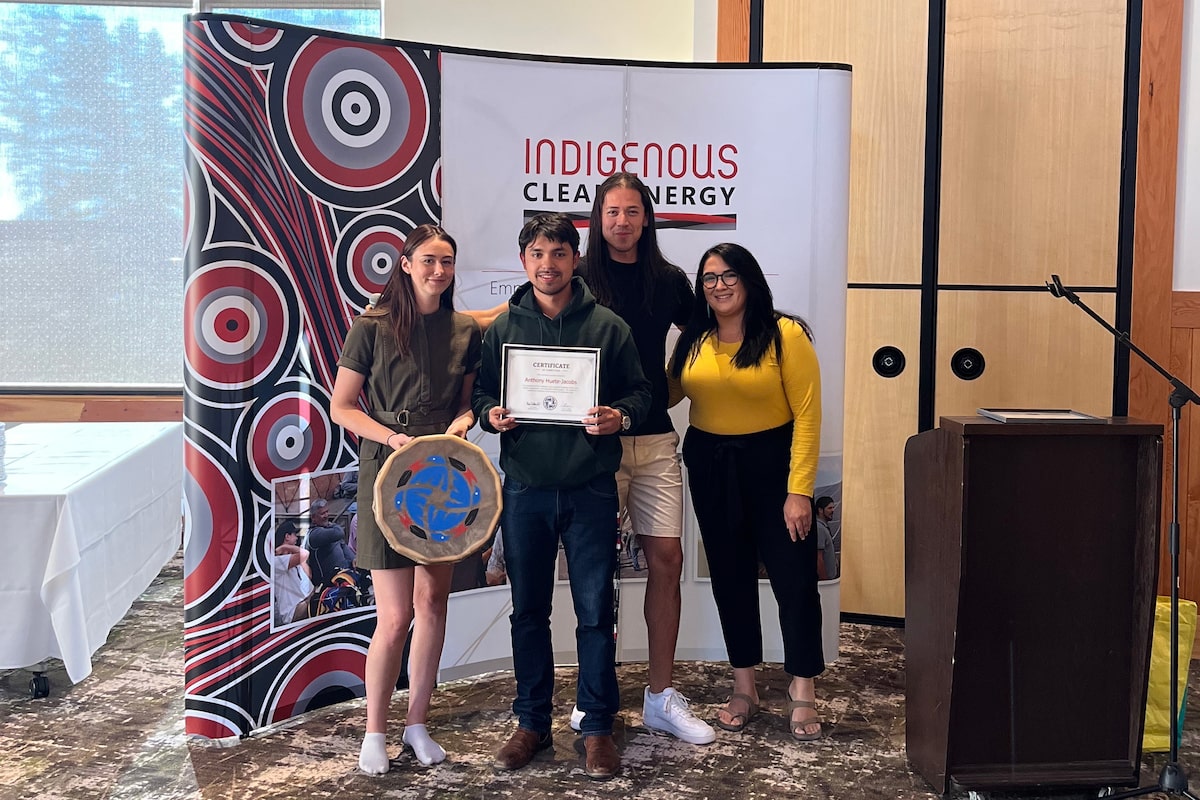


Anthony Huete-Jacobs holds a certificate at the cohort one Generation Power graduation ceremony in Saskatchewan, on Sept. 11, 2022, at Wanuskwin.courtesy Anthony Huete-Jacobs
Nestled amidst the pristine wilderness of British Columbia’s Northern Rockies lies Fort Nelson, a community that was forever changed by the gas industry. Hydraulic fracturing, or fracking, for shale gas extraction transformed this remote corner of Canada into a battleground of environmental concerns and economic aspirations.
“My territory is rich in natural resources like oil, gas, timber and water. Oil and gas industries have come and ravaged and exploited these resources for their benefits,” says Taylor Behn-Tsakoza, a member of the Fort Nelson First Nation.
For a while, Fort Nelson’s streets were bustling, and its economy was thriving. Then, as quickly as companies rushed in to capitalize off the energy boom, they were gone.
The downturn in the gas sector, beginning in 2008, resulted in numerous job losses, business shutdowns and a decrease in real estate values, not to mention deserted gas wells, wastewater pits, aging compressor stations and abandoned pipelines snaking through the territory.
Since then, Fort Nelson First Nation is making efforts to clean up the damage, and shift from fossil fuels to clean and renewable energy.
Indigenous lands are often the birthplace of clean energy initiatives aimed at repairing the damage done by gas extraction, addressing environmental degradation and economic challenges alike. These projects are made even more personal by Indigenous peoples’ connections to the land.
In 2015, for example, the First Nation won a decision from the B.C. Environmental Appeal Board that stopped the company, Nexen, from being granted a long-term license to extract 2.5 billion litres of water a year from a small lake about 90 kilometres northeast of Fort Nelson.
Inspired by efforts like these, Behn-Tsakoza signed up for a program called Generation Power in 2022. The program, developed by the Indigenous Clean Energy social enterprise (ICE), provides training and mentorship opportunities to Indigenous youth participating in clean energy projects.
At that time, Behn-Tsakoza was working in administration for the Tu Deh-Kah geothermal project launched by Fort Nelson First Nation, which involves repurposing old gas wells into geothermal wells to generate clean electricity.
“This renewable energy project was being marketed as a way to repair the land and work with industry in a way that was going to benefit my community, that was going to consider the environment, and that was going to consider our traditional knowledge,” says Behn-Tsakoza, who is now a community liaison for Tu Deh-Kah.
She says that Generation Power provided her with knowledge and training in clean energy transition to support the Tu Deh-Kah geothermal project.
James Jenkins, ICE’s executive director, says programs like Generation Power are designed to help youth pursue careers in the clean energy sector.
“The demand for those [programs] is only going to increase as the provinces and territories increase their energy capabilities over the next 10 years,” he says.
On June 5, 2023, Natural Resources Canada announced an investment of over $30-million to create green jobs and training opportunities for youth in the natural resources sector, including in the fields of energy, forest, mining, earth science and clean technology.
ICE is one of the participating organizations, offering a minimum of 70 job placements over two years for Indigenous youth through its Generation Power program.
In 2022, Generation Power alum Anthony Huete-Jacobs was matched with Natural Resources Canada for a six-month internship and secured a full-time job at the end.
Huete-Jacobs currently works as a program delivery officer at Wah-ila-toos, an initiative run jointly between the Government of Canada and an Indigenous council that funds clean energy projects in Indigenous, rural and remote communities.
“I feel like I sort of have this due diligence with respect to my Indigenous communities,” he says.
Huete-Jacobs is Anishinaabe from the Aamjiwnaang First Nation. His community lives near Chemical Valley, an area with 75 per cent air pollution, according to a report by Yellowhead Institue and the University of Toronto’s Technoscience Research Unit.
“We’ve had people pass way. Our fish has been poisoned and that’s our source of food,” he says. “Being able to change that narrative … clean energy helps us to that. It helps push us forward.”
W Dusk Energy Group is an Indigenous-owned firm that’s helping First Nations across the country integrate renewable energy projects into their community. It’s currently developing a green hydrogen project that’s set to be B.C.’s first fully solar community, according to David Isaac, W Dusk’s president.
The firm has previously helped Fisher River Cree Nation build a solar farm in Manitoba and completed two of B.C.’s largest Indigenous-owned solar projects.
“First Nations and Indigenous Communities are generally the communities that are in the sacrifice zones, are on the front lines of resource extraction,” Isaac says. “So, it’s poetic that the emergence of sustainable infrastructure is being led by First Nations communities across Canada.”
It’s important to use technologies that don’t harm the environment and that align with Indigenous knowledge and values, Isaac says. Community-led renewable energy initiatives in rural areas are symbolic of a shift toward redefining communities on Indigenous peoples’ terms.
“Colonialism is completely intertwined with oil, gas, and natural resources extraction,” he says. “And so, in order to untangle from colonialism and to really decolonize, we’re going to have to decarbonize.”